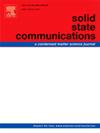Effect of anisotropic parameters on some properties of the vHs superconductor in kagome materials
IF 2.1
4区 物理与天体物理
Q3 PHYSICS, CONDENSED MATTER
引用次数: 0
Abstract
In this work, we use the anisotropy energy gap and the van Hove singularity in the density of states to define various properties of multilayer kagome superconductors in the weak coupling limit. The multilayer characteristics of kagome superconductors can be represented using either the Haas and Maki anisotropic model (HM) or the Posazhennikova, Dahm, and Maki model (PDM). We found that the HM model is better suited for characterizing kagome superconductors than the PDM model. Following these calculations, the isotope effect exponent, gap-to-Tc ratio, and specific heat jump were investigated using equations and numerical data. The isotope exponent (0.12) and specific heat jump (0.88–1.33) are both lower than BCS predictions; however, the gap-to-Tc ratio (5.32–5.68) exceeds BCS expectations.
各向异性参数对kagome材料中vHs超导体某些特性的影响
在这项工作中,我们利用态密度中的各向异性能隙和van Hove奇点来定义弱耦合极限下多层kagome超导体的各种性质。kagome超导体的多层特性可以用Haas和Maki各向异性模型(HM)或Posazhennikova, Dahm和Maki模型(PDM)来表示。我们发现HM模型比PDM模型更适合于表征kagome超导体。在此基础上,利用方程和数值数据研究了同位素效应指数、gap-to-Tc比和比热跃变。同位素指数(0.12)和比热跃(0.88 ~ 1.33)均低于BCS预测;然而,gap-to-Tc比率(5.32-5.68)超出了BCS的预期。
本文章由计算机程序翻译,如有差异,请以英文原文为准。
求助全文
约1分钟内获得全文
求助全文
来源期刊

Solid State Communications
物理-物理:凝聚态物理
CiteScore
3.40
自引率
4.80%
发文量
287
审稿时长
51 days
期刊介绍:
Solid State Communications is an international medium for the publication of short communications and original research articles on significant developments in condensed matter science, giving scientists immediate access to important, recently completed work. The journal publishes original experimental and theoretical research on the physical and chemical properties of solids and other condensed systems and also on their preparation. The submission of manuscripts reporting research on the basic physics of materials science and devices, as well as of state-of-the-art microstructures and nanostructures, is encouraged.
A coherent quantitative treatment emphasizing new physics is expected rather than a simple accumulation of experimental data. Consistent with these aims, the short communications should be kept concise and short, usually not longer than six printed pages. The number of figures and tables should also be kept to a minimum. Solid State Communications now also welcomes original research articles without length restrictions.
The Fast-Track section of Solid State Communications is the venue for very rapid publication of short communications on significant developments in condensed matter science. The goal is to offer the broad condensed matter community quick and immediate access to publish recently completed papers in research areas that are rapidly evolving and in which there are developments with great potential impact.
 求助内容:
求助内容: 应助结果提醒方式:
应助结果提醒方式:


